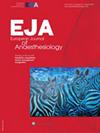A survey and analysis of peri-operative quality indicators promoted by National Societies of Anaesthesiologists in Europe: The EQUIP project.
IF 4.2
2区 医学
Q1 ANESTHESIOLOGY
引用次数: 0
Abstract
BACKGROUND To capture preventable peri-operative patient harm and guide improvement initiatives, many quality indicators (QIs) have been developed. Several National Anaesthesiologist Societies (NAS) in Europe have implemented quality indicators. To date, the definitions, validity and dissemination of such quality indicators, and their comparability with validated published indicators are unknown. OBJECTIVES The aim of this study was to identify all quality indicators promoted by NAS in Europe, to assess their characteristics and to compare them with published validated quality indicators. DESIGN A cross-sectional study with mixed methods analysis. Using a survey questionnaire, representatives of 37 NAS were asked if their society provided quality indicators to their members and, if so, to provide the list, definitions and details of quality indicators. Characteristics of reported quality indicators were analysed. SETTING The 37 NAS affiliated with the European Society of Anaesthesiology and Intensive Care (ESAIC) at the time. Data collection, translations: March 2018 to February 2020. PARTICIPANTS Representatives of all 37 NAS completed the survey. MAIN OUTCOME MEASURES QIs reported by NAS. RESULTS Only 12 (32%) of the 37 NAS had made a set of quality indicators available to their members. Data collection was mandatory in six (16.2%) of the 37 countries. We identified 163 individual quality indicators, which were most commonly descriptive (60.1%), anaesthesia-specific (50.3%) and related to intra-operative care (21.5%). They often measured structures (41.7%) and aspects of safety (35.6%), appropriateness (20.9%) and prevention (16.6%). Patient-centred care (3.7%) was not well covered. Only 11.7% of QIs corresponded to published validated or well established quality indicator sets. CONCLUSIONS Few NAS in Europe promoted peri-operative quality indicators. Most of them differed from published sets of validated indicators and were often related to the structural dimension of quality. There is a need to establish a European-wide comprehensive core set of usable and validated quality indicators to monitor the quality of peri-operative care. TRIAL REGISTRATION No registration.欧洲各国麻醉医师协会推广的围手术期质量指标调查与分析:EQUIP 项目。
背景为了掌握可预防的围手术期患者伤害并指导改进措施,已制定了许多质量指标(QIs)。欧洲的一些国家麻醉医师协会(NAS)已经实施了质量指标。本研究旨在确定欧洲国家麻醉师协会推广的所有质量指标,评估这些指标的特点,并将其与已公布的有效质量指标进行比较。通过调查问卷,询问了 37 个 NAS 的代表其协会是否向会员提供质量指标,如果提供,请提供质量指标的列表、定义和详细信息。对报告的质量指标的特点进行了分析。调查对象当时隶属于欧洲麻醉学和重症监护学会(ESAIC)的37个NAS。数据收集、翻译:结果37个NAS中只有12个(32%)向其成员提供了一套质量指标。在 37 个国家中,有 6 个国家(16.2%)强制要求收集数据。我们确定了 163 个质量指标,其中最常见的是描述性指标(60.1%)、麻醉专用指标(50.3%)以及与术中护理有关的指标(21.5%)。这些指标通常衡量结构(41.7%)、安全性(35.6%)、适当性(20.9%)和预防性(16.6%)。以病人为中心的护理(3.7%)没有得到很好的覆盖。只有 11.7% 的质量指标与已公布的有效或成熟的质量指标集一致。大多数质量指标与已公布的验证指标集不同,通常与质量的结构维度有关。有必要在欧洲范围内建立一套全面的、可用的、经过验证的核心质量指标,以监测围手术期护理的质量。
本文章由计算机程序翻译,如有差异,请以英文原文为准。
求助全文
约1分钟内获得全文
求助全文
来源期刊
CiteScore
6.90
自引率
11.10%
发文量
351
审稿时长
6-12 weeks
期刊介绍:
The European Journal of Anaesthesiology (EJA) publishes original work of high scientific quality in the field of anaesthesiology, pain, emergency medicine and intensive care. Preference is given to experimental work or clinical observation in man, and to laboratory work of clinical relevance. The journal also publishes commissioned reviews by an authority, editorials, invited commentaries, special articles, pro and con debates, and short reports (correspondences, case reports, short reports of clinical studies).

 求助内容:
求助内容: 应助结果提醒方式:
应助结果提醒方式:


